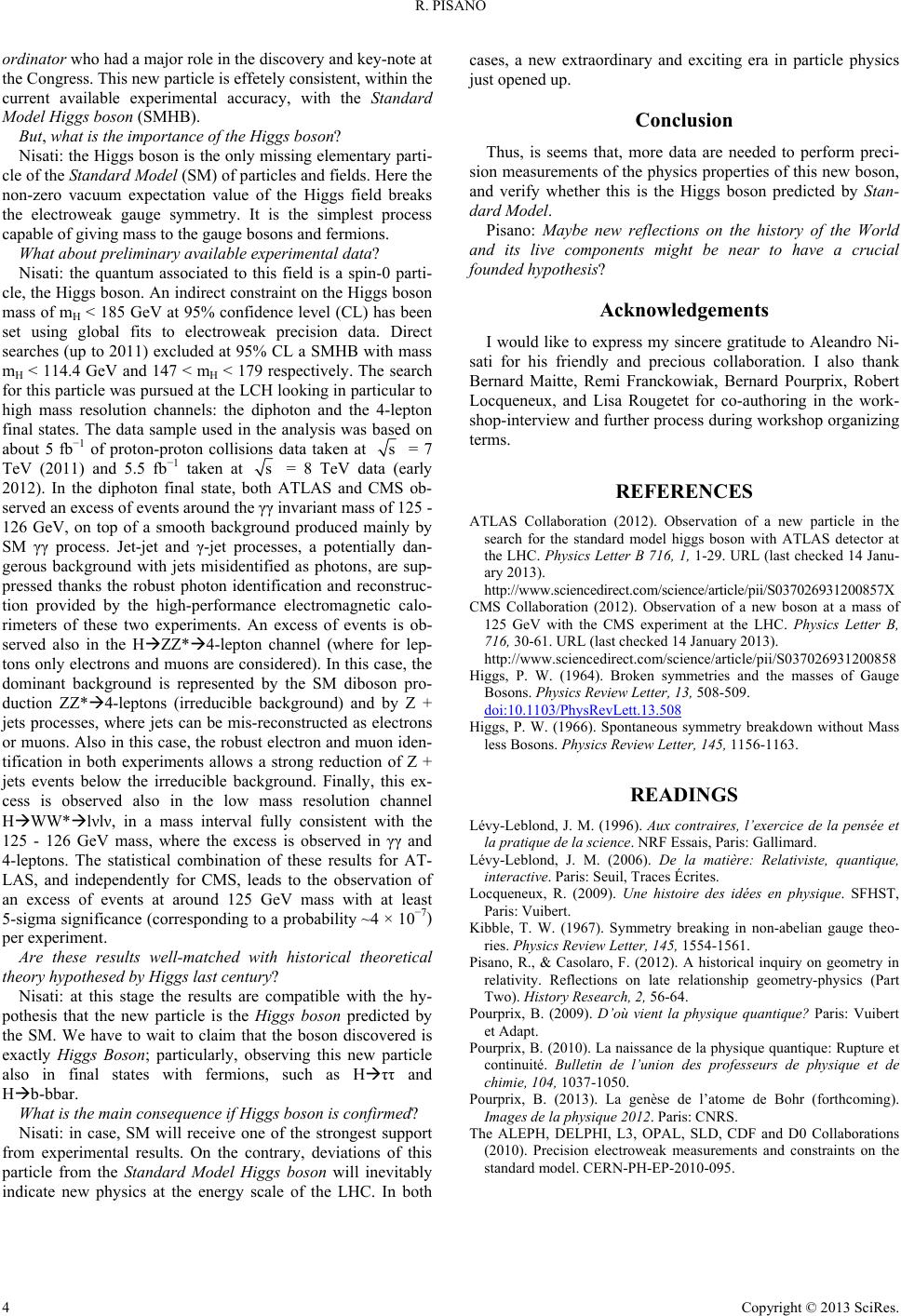
R. PISANO
ordinator who had a major role in the discovery and key-note at
the Congress. This new particle is effetely consistent, within the
current available experimental accuracy, with the Standard
Model Higgs boson (SMHB).
But, what is the importance of the Higgs boson?
Nisati: the Higgs boson is the only missing elementary parti-
cle of the Standard Model (SM) of particles and fields. Here the
non-zero vacuum expectation value of the Higgs field breaks
the electroweak gauge symmetry. It is the simplest process
capable of giving mass to the gauge bosons and fermions.
What about preliminary available experimental data?
Nisati: the quantum associated to this field is a spin-0 parti-
cle, the Higgs boson. An indirect constraint on the Higgs boson
mass of mH < 185 GeV at 95% confidence level (CL) has been
set using global fits to electroweak precision data. Direct
searches (up to 2011) excluded at 95% CL a SMHB with mass
mH < 114.4 GeV and 147 < mH < 179 respectively. The search
for this particle was pursued at the LCH looking in particular to
high mass resolution channels: the diphoton and the 4-lepton
final states. The data sample used in the analysis was based on
about 5 fb−1 of proton-proton collisions data taken at s = 7
TeV (2011) and 5.5 fb−1 taken at s = 8 TeV data (early
2012). In the diphoton final state, both ATLAS and CMS ob-
served an excess of events around the γγ invariant mass of 125 -
126 GeV, on top of a smooth background produced mainly by
SM γγ process. Jet-jet and γ-jet processes, a potentially dan-
gerous background with jets misidentified as photons, are sup-
pressed thanks the robust photon identification and reconstruc-
tion provided by the high-performance electromagnetic calo-
rimeters of these two experiments. An excess of events is ob-
served also in the HZZ*4-lepton channel (where for lep-
tons only electrons and muons are considered). In this case, the
dominant background is represented by the SM diboson pro-
duction ZZ*4-leptons (irreducible background) and by Z +
jets processes, where jets can be mis-reconstructed as electrons
or muons. Also in this case, the robust electron and muon iden-
tification in both experiments allows a strong reduction of Z +
jets events below the irreducible background. Finally, this ex-
cess is observed also in the low mass resolution channel
HWW*lνlν, in a mass interval fully consistent with the
125 - 126 GeV mass, where the excess is observed in γγ and
4-leptons. The statistical combination of these results for AT-
LAS, and independently for CMS, leads to the observation of
an excess of events at around 125 GeV mass with at least
5-sigma significance (corresponding to a probability ~4 × 10−7)
per experiment.
Are these results well-matched with historical theoretical
theory hypothesed by Higgs last century?
Nisati: at this stage the results are compatible with the hy-
pothesis that the new particle is the Higgs boson predicted by
the SM. We have to wait to claim that the boson discovered is
exactly Higgs Boson; particularly, observing this new particle
also in final states with fermions, such as Hττ and
Hb-bbar.
What is the main consequence if Higgs boson is confirmed?
Nisati: in case, SM will receive one of the strongest support
from experimental results. On the contrary, deviations of this
particle from the Standard Model Higgs boson will inevitably
indicate new physics at the energy scale of the LHC. In both
cases, a new extraordinary and exciting era in particle physics
just opened up.
Conclusion
Thus, is seems that, more data are needed to perform preci-
sion measurements of the physics properties of this new boson,
and verify whether this is the Higgs boson predicted by Stan-
dard Model.
Pisano: Maybe new reflections on the history of the World
and its live components might be near to have a crucial
founded hypothesis?
Acknowledgements
I would like to express my sincere gratitude to Aleandro Ni-
sati for his friendly and precious collaboration. I also thank
Bernard Maitte, Remi Franckowiak, Bernard Pourprix, Robert
Locqueneux, and Lisa Rougetet for co-authoring in the work-
shop-interview and further process during workshop organizing
terms.
REFERENCES
ATLAS Collaboration (2012). Observation of a new particle in the
search for the standard model higgs boson with ATLAS detector at
the LHC. Physics Letter B 716, 1, 1-29. URL (last checked 14 Janu-
ary 2013).
http://www.sciencedirect.com/science/article/pii/S037026931200857X
CMS Collaboration (2012). Observation of a new boson at a mass of
125 GeV with the CMS experiment at the LHC. Physics Letter B,
716, 30-61. URL (last checked 14 January 2013).
http://www.sciencedirect.com/science/article/pii/S037026931200858
Higgs, P. W. (1964). Broken symmetries and the masses of Gauge
Bosons. Physics Review Letter, 13, 508-509.
doi:10.1103/PhysRevLett.13.508
Higgs, P. W. (1966). Spontaneous symmetry breakdown without Mass
less Bosons. Physics Review Letter, 145, 1156-1163.
READINGS
Lévy-Leblond, J. M. (1996). Aux contraires, l’exercice de la pensée et
la pratique de la scie n c e. NRF Essais, Paris: Gallimard.
Lévy-Leblond, J. M. (2006). De la matière: Relativiste, quantique,
interactive. Paris: Seuil, Traces Écrites.
Locqueneux, R. (2009). Une histoire des idées en physique. SFHST,
Paris: Vuibert.
Kibble, T. W. (1967). Symmetry breaking in non-abelian gauge theo-
ries. Physics Review Letter, 145, 1554-1561.
Pisano, R., & Casolaro, F. (2012). A historical inquiry on geometry in
relativity. Reflections on late relationship geometry-physics (Part
Two). History Research, 2, 56-64.
Pourprix, B. (2009). D’où vient la physique quantique? Paris: Vuibert
et Adapt.
Pourprix, B. (2010). La naissance de la physique quantique: Rupture et
continuité. Bulletin de l’union des professeurs de physique et de
chimie, 104, 1037-1050.
Pourprix, B. (2013). La genèse de l’atome de Bohr (forthcoming).
Images de la physique 2012. Paris: CNRS.
The ALEPH, DELPHI, L3, OPAL, SLD, CDF and D0 Collaborations
(2010). Precision electroweak measurements and constraints on the
standard model. CERN-PH-EP-2010-095.
Copyright © 2013 SciRes.
4